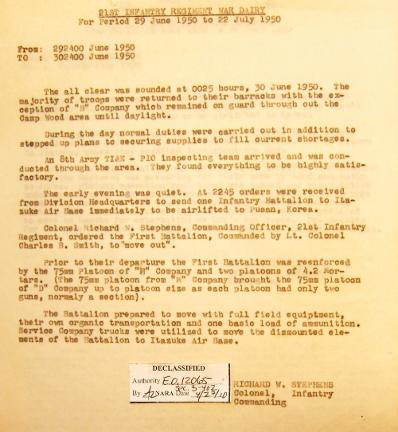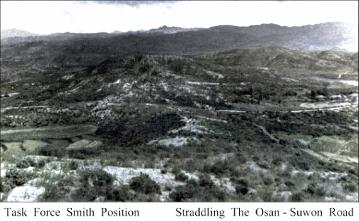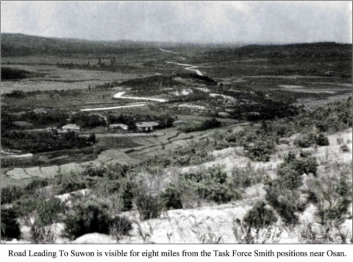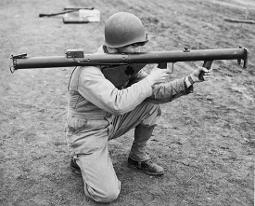THE BATTLE AT OSAN-TASK FORCE SMITH
THIS SECTION HAS BEEN REVISED TO REFLECT INFORMATION GATHERED FROM PERSONAL NARRATIVES OF TEN INDIVIDUALS WHO WERE PRESENT DURING THE BATTLE
I am writing this section based on the official records at the National Archives at College Park, Maryland, and modifying it using personal narratives by four officers and five enlisted men who were present at the battle, including one who was captured at Osan on July 5, 1950 and who was not released until late August, 1953. These records include the War Diary for the Eighth Army, War Diaries and Unit Histories of the 24th Infantry Division, the 21st Infantry Regiment and the 52d Field Artillery Battery of the 24th Infantry Division. Other source documents include memorandums of telephone calls and radio messages, including documents on file at the Army Military History Institute at Carlisle, Pennsylvania. Unique to the Army Military History Institute are documents and personal narratives by some of the participants which were gathered by that institute by means of questionnaires sent to a large number of Army personnel who served in Korea during the period from June 1950 through August 1953. I published an article in the March-April 2012 issue of the Korean War Veterans Association magazine "Korea Veterans The Graybeards". As a result, I received copies of personal narratives of men who participated in the battle at Osan. Most of them were from the daughter of one of the participants, Norman Fosness. She is also the official historian for the 21st Infantry Regiment. I also exchanged phone calls and e-mails with 2d Lieutenant Brian Macaulay who was the Platoon Leader of the second platoon of B Company of the 21st Infantry Regiment.
Those men were:
1. Sergeant Ezra P. Burke, who was the Non-Commissioned Officer in charge of the 40 man medical platoon of the 21st Infantry Regiment, 24th Infantry Division, which accompanied Task Force Smith. He received a shrapnel wound to the head at the beginning of the retreat. He assisted another wounded man for about two of the four days it took him to get back to our lines.
2. Herman V. Critchfield was a 25 year old Corporal who arrived in Japan just in time to leave with Battery A of the 52d Field Artillery Battalion, 24th Infantry Division which went to Korea in support of Task Force Smith. As a result of his previous experience, he was assigned as head gunner on the forward "direct fire" howitzer.
3. Private Robert Fitzgerald, who was a gunner in Battery A of the 52d Field Artillery Battalion, 24th Infantry Division. He was "volunteered" to be a gunner on one of the two .50 caliber machine guns which Lt. Colonel Perry, Commander of the 52d Field Artillery Battalion, detailed to augment the firepower of the infantry component of the task force. Private Fitzgerald was captured at Osan and was released on 23 August 1953.
4. Corporal Norman Fosness, the Browning Automatic Rifleman (BAR) in the 3d squad of the first platoon of B Company, 21st Infantry Regiment, 24th Infantry Division.
5. Sergeant Clifford Johnson, Headquarters and Headquarters Company, First Battalion, 21st Infantry Regiment, 24th Infantry Division. His account is probably the most accurate as he wrote a long letter to his wife on September 12, 1950, which described everything that happened to him from the time they were alerted to leave for Korea up until the time he wrote the letter.
6. 2d Lieutenant Alan Brian Macaulay, Platoon Leader of the 2d Platoon, of B Company.
7. Lieutenant Colonel Miller O. Perry, Commanding Officer of the 52d Field Artillery Battalion (FA Bn) of the 24th Infantry Division. (Original narrative on file at the Army Military History Institute at Carlisle, Pennsylvania.)
8. 1st Lieutenant Dwain Scott, Commander of Battery A of the 52d FA Bn. (Original narrative on file at the Army Military History Institute at Carlisle, Pennsylvania).
9. PFC William Thornton, Squad Leader, 3d Squad, First Platoon, B Company, 21st Infantry Regiment, 24th Infantry Division. (Original narrative on file at the Army Military History Institute at Carlisle, Pennsylvania.)
10. 2d Lieutenant (Later Colonel) William Wyrick, Platoon Leader in C Company, 21st Infantry Regiment, 24th Infantry Division. (Original narrative on file at the Army Military History Institute at Carlisle, Pennsylvania).
I am including information furnished by a newspaper reporter, Peter Kalisher. He interviewed Master Sergeant William Schellinger, the First Sergeant of Company B, 21st Infantry Regiment, 24th Infantry Division. Sergeant Schellinger witnessed the attack of four Royal Australian Air Force P-51's which mistakenly attacked the unit at Pyongtaek. destroying some recoilless rifle ammunition as well as destroying a trainload of ammunition at the railroad station in Pyongtaek which was destined for delivery to the South Korean Army. Sergeant Schellinger was killed during the battle at Osan on 5 July, 1950.
The battle at Osan is especially important because it marks the first time that American ground forces engaged in combat in the over five years since the end of World War Two. For a detailed coverage of discrepancies between "official" records and actual facts, see the chapter on "Task Force Smith-Critique of Official Documents".
On June 30th at 2345 hours, Colonel Richard W. Stephens, Commander of the 21st Infantry Regiment of the 24th Infantry Division received orders to send one infantry battalion to Itazuke Air Base for immediate airlift to Pusan, Korea. The entire division was alerted and the G-3 (Operations Officer) for Air was sent to Itazuke to coordinate the airlift. Lieutenant Colonel Charles B. Smith, who was commander of the First Battalion, was placed in command of the task force (later designated "Task Force Smith").
General Walker had issued a directive requiring that the first units going to Korea were required to be at full Table of Organization and Equipment strength. For some reason, either Colonel Stephens or Colonel Smith requested that Task Force Smith be exempted from that requirement and that request was approved. As a result, that force was less than half strength. Rifle Platoons with an authorized strength of 42 men had an actual strength of 18 to 20 men. In stark contrast, the Artillery Unit under Lt. Colonel Miller O. Perry was short only 6 men and had his full complement of vehicles and individual and crew served weapons. He even had cooks, field stoves and food supplies whereas the Infantry unit had only C-rations.
The task force was actually two reinforced rifle companies, which was less than half of a battalion. Prior to their departure the task force was reinforced by a 75mm recoilless rifle section from "M" Company, which was the Heavy Weapons Company of the 2d Battalion and two platoons (four 4.2 heavy mortars each) from D Company, which was the Heavy Weapons Company for the 1st Battalion. The force, as finally constituted, was made up of half of the Battalion Headquarters Company and half of Service Company, two understrength rifle companies, one 75mm recoilless rifle platoon, two 4.2 inch heavy mortar platoons and six bazooka teams. The first part of the task force left Kumamoto at 0300 on 1 July. Their departure began during the middle of a driving monsoon rain. Part of the task force left by rail, but the recoilless rifle platoon the two Heavy Mortar platoons and the heavy machine gun crews drove using their own vehicles, transporting their weapons and ammunition. The last of the task force arrived at Itazuke at 9:20 AM that same day. According to the War Diaries there were 24 C-54 transports were allotted for the airlift. However, Lt. Colonel Smith told Roy Appleman that there were only six available. A review of copies of multiple memorandums of telephone conversations, including one made by Lt. Colonel Smith, show that there were a minimum of fifteen C-54's available. Based on the narrative by Lt. Brian Macaulay, there was a jeep and trailer on board the C-54 his platoon was on, but he did not remember whether it was a mortar or a recoilless rifle team. That plane was the third to leave, but the first to arrive at Pusan on the early afternoon of July 1. Sergeant Cliff Johnson, a member of Battalion Headquarters Company, wrote that only about 120 men made it to Pusan on 1 July. He wrote that the balance (most of companies B and C, the Communications Platoon from Headquarters Company, a few other men from Battalion Headquarters. two 75mm recoilless rifle sections, one section of heavy mortars and about 20 medics) arrived the next morning.
The 8th Army War Diary for 2 July 1950 states that by 8:15 two C54's had landed at Pusan and that eight more were already in the air. The 21st Infantry Regimental War Diary for July 3 states that one heavy mortar platoon, consisting of four 4.2 inch mortars, each with a crew of four were attached to each of the rifle companies.
Headquarters, 8th Army ordered that for the first units to go to Korea, shortages in men and equipment were to be made up from within the 24th Infantry Division. Units leaving later would have shortages made up by transferring men and equipment from other units. As an example, on 3 July 1950, 732 senior enlisted men were transferred to the 24th Infantry Division from the First Cavalry Division. THAT DIRECTIVE WAS NOT FOLLOWED BY THE INFANTRY COMMANDER AS 2D LT. WYRICK, A PLATOON LEADER IN C COMPANY STATED THAT HE ONLY HAD 18 OFTHE 42 MEN AUTHORIZED IN HIS PLATOON. 2D LT MACAULAY, A PLATOON LEADER IN B COMPANY, STATED THAT HE HAD ONLY ABOUT 30 OF THE 42 MEN AUTHORIZED IN HIS PLATOON. Apparently, only the Artillery component followed the directive. The personal narrative of Lt. Colonel Miller O. Perry, who was the commander of the 52d FA Bn, 24th Infantry Division, states that his unit was brought up to full strength in men and equipment by transfers from other artillery units of the 24th Infantry Division.
Using the Korean War Casualty file in the National Archives "Access to Archival Files", commonly referred to as "AAD", I extracted the names, ranks and organizations of the men who were casualties on July 5th. There were several men who were NOT listed as members of the 21st Infantry Regiment. The one casualty who was not with Task Force Smith was a soldier by the name of Shattuck. He was a bazooka gunner assigned to the 34th Infantry Regiment and part of a team who, along with a newspaper reporter, was sent to intercept the tanks which had passed through the Task Force Smith position. He fired at a T-34 tank and after firing, stood up to see if he had hit it and was killed by a burst of machine gun fire from that tank.
Since there were no other units in combat on that date, it is logical to assume that all casualties incurred on that date, with the one exception just mentioned, were members of or attached to one of the units of Task Force Smith and were present at the battle or during the ensuing retreat.
The task force prepared to move with full field equipment (The War Diary specified that all other items would be left in their barracks under lock and key). During my time with the First Cavalry Division, full field equipment consisted of filling a field pack with extra clothes, mess gear, shaving gear, toiletries and extra socks. Attached to and hung over the top and sides of the pack were a shelter half, blanket, rain gear and hanging on the back were an entrenching tool and our steel helmet. Attached to the bottom of the field pack was a "butt" pack filled with C Rations, extra ammo and more socks. When going into a combat situation, the field pack would be disposed of because of the extra weight and bulk. Our cartridge belts held ten eight round Garand clips, attached to the cartridge belt were a bayonet in its scabbard, first aid kit with two bandages and our canteen which was sitting in our drinking cup.
A copy of the 21st Infantry Regimental War Diary for 30 June 1950 is shown below. It shows the initial composition of the Task Force.
The War Diary indicates that 24 C-54 aircraft were available for the airlift. A copy of a memorandum of phone call which was made at 11:35 AM on July 1 indicates that two planes were off, beginning at 11:05 AM and that there were 13 more ready to leave at 20 minute intervals.
Due to the bad weather, the first two planes had to return to Itazuke. The third plane managed to land. According to Lt. Brian Macaulay, a platoon commander in B Company, he and his understrength platoon were accompanied by at least one and possibly two 4.2 inch mortar crews along with their jeeps and trailers. He says he was surprised when he was told that their plane was to first to land. When the first plane, carrying Lt. Colonel Smith and Sergeant Johnson, returned to Itazuke, the first priority was to refuel and immediately leave for Pusan. The same thing happened with the second plane to return. They were both probably back in the air within 45 minutes of landing. The first one probably landed back at Itazuke sometime around 1330 and the second shortly before 1400. .
According to Sergeant Clifford Johnson, only about 120 of the men assigned to the infantry portion of Task Force Smith arrived on 1 July. That 120 men included about 20 enlisted men and 2 officers of the Medical Platoon.
Retired Colonel William Wyrick, who was a 2d Lt. platoon commander in C Company states that he and his half strength platoon spent the night of July 12 in a hanger at Itazuke. He writes that in the morning of July 2, he and his men were loaded onto a C-54 along with what he describes as heavy equipment and that they flew at wave top height to Pusan to avoid YAK fighters which were reported to be in the air. Since the only heavy equipment were the 4.2 inch mortars, it is probable that one or two mortar crews made the trip to Pusan on that same plane.
Sergeant Ezra Burke, the Non-Commissioned Officer in charge of the 40 man Medical Platoon wrote that Captain Edwin Overholt, a Medical Corps surgeon and the Medical Platoon commander, 1st Lt. Raymond Adams and half of the medical platoon left in a C-54 on July 1. He and the rest of the platoon flew to Pusan the next day in a C-47 transport, but that they had to leave their litter jeep behind because it was too large to be loaded on the C-47.
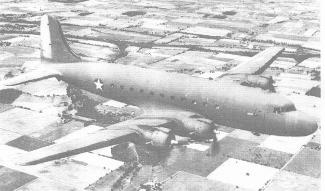
DOUGLAS C-54 SKYMASTER IS SHOWN ABOVE. THIS MODEL WAS ALSO USED TO TRANSPORT PRESIDENTS ROOSEVELT AND TRUMAN. THEY HAD A RANGE OF 2,500 MILES AND A TOP SPEED OF ABOUT 280 MILES PER HOUR.
General MacArthur's personal plane, the "Bataan" was also a C-54. They could transport 50 fully armed and equipped soldiers or a total of 32,500 pounds of cargo. There were only three fields in South Korea with runways long enough for them to operate in and out of. They were Kimpo Airfield near Seoul, Suwon Airfield south of Seoul and the one at the southern port of Pusan.
At 1525 (3:25 PM civilian time), two planes were in the air enroute to Pusan, where the visibility at that time was about ten miles. All of the other planes were loaded and ready to go, but a total of only about nine planes made it to Pusan. A copy of the memorandum of phone call is shown below.
After the last plane landed in the afternoon of July 1, 1950, all personnel and equipment were loaded on a train headed for Taejon, where they arrived early in the morning of July 2d.
Two more planes had landed at Pusan by 0815 on July 2 and a total of eight more were expected to land by 0915. After the last plane landed, all personnel and equipment were loaded on a train leaving for Taejon, arriving there that evening. According to a narrative by Colonel Wyrick (then a 2d Lt.) Lt. Colonel Smith and all the men who had arrived the day before had already left for Taejon by train. All of the personnel and equipment which arrived on July 2, were put on a train for Taejon, arriving there after dark on 2 July.
Six 105mm howitzers, 73 vehicles, on half of Headquarters Battery, One half of Service Battery and all of Battery B and 180 men of the 52d Field Artillery Battalion (52d FA Bn) of the 24th Infantry Division left Hakata, Japan on a Landing Ship Tank (LST) at 0700 on 2 July, arriving in Pusan at 1900 the same day. This information is based on the personal narrative of Lt. Colonel Miller O. Perry, Battalion Commander and the War Diary of the 52d FA Bn. In his narrative, Lt. Colonel Miller stated that all shortages of men and equipment were made up by transferring men and equipment from other artillery units of the 24th Division.
Authorized strength of Service Battery was 81 enlisted men and 3 officers. Half of that would be 40 men and 1 or 2 officers. Headquarters Battery was authorized 147 enlisted men and 15 officers. Half of that would be 73 enlisted men and 7 officers. In all, there should have been 240 enlisted men and 14 or 15 officers, so they were actually about 60 men short. Official documents and personal narratives by both Lt. Colonel Perry and 1st Lt. Dwain Scott shows that there were a total of 11 American officers and a South Korean artillery officer named Yoon present at the battle on July 5. Five of the American officers were from the Headquarters Battery plus one Korean Military Advisory Group (KMAG) officer, 1st Lieutenant Everett G Scott, Serial Number O-550568.
Lt. Scott wrote that, aside from ammunition at the two artillery locations, all of the other ammunition was at one location.
During the morning of 2 July 1950, parts of Companies B and C, the 75mm Recoilless Rifle platoons of D and M Companies and 1st Battalion Headquarters which had not arrived on July 1 completed their arrival at Pusan Airport. They went to the Pusan railroad station and boarded trains which immediately left for Taejon, arriving there after dark on July 2. Photo showing part of the task force appears below.
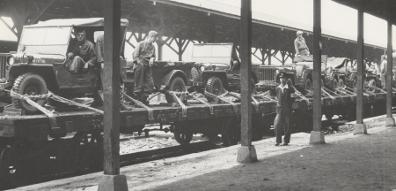
PART OF TASK FORCE SMITH LOADED ON RAILROAD CARS AT PUSAN RAILROAD STATION ON 2 JULY 1950
Men of Task Force Smith, minus those who had left the night before, loaded onto freight cars at the Pusan Railroad Station, probably sometime in the early afternoon as the last of them had landed at the Pusan airport sometime between 0900 and 1000. Because all of the jeeps have trailers, the men shown are either from one of the 4.2 inch mortar platoons or from the Recoilless Rifle sections as both type units require jeeps with trailers for carrying equipment and ammunition. The men arrived at Taejon after dark that same day.
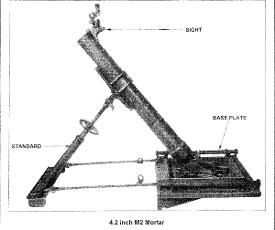
EACH MORTAR HAD A CREW OF 4. THE BASEPLATE WEIGHT 175 POUNDS, THE BARREL 105 POUNDS AND THE STANDARD/SUPPORT WEIGHED 53 POUNDS FOR A TOTAL OF 333 POUNDS. THIS WAS ALL TRANSPORTED IN A TRAILER HITCHED TO A JEEP.
When General Dean gave his orders to Lt. Colonel Smith at Itazuke on the morning of 1 July, he had instructed Colonel Smith go go as far north as he could. While awaiting the arrival of the balance of his task force, Lt. Colonel Smith and the officers who had arrived with him (Includsing 2d Lt. Brian Macaulay) drove to a point just north of Osan where he picked out the ideal point for setting up a defense against the North Koreans. However, the next morning the task force was split into two groups by the overcautious Brigadier General Church. He was in command of US Army Forces in Korea (USAFIK) pending the arrival of Major General Dean.
The first group, commanded by Lt. Colonel Smith went to Pyongtaek by rail. His group included Company B, commanded by 1st Lt. Thomas; one 4.2 inch mortar platoon, two 75mm recoilless rifles (RR) from M Company and part of Headquarters and Headquarters Company, 1st Battalion. Their mission was ato block the dry river bed running into Pyongtaek from the north. They were also to establish road blocks on all roads and rail lines running into Pyongtaek from the north.
On July 3d, this group was subjected to six strafing attacks by Royal Australian Air Force P-51's. These same aircraft also strafed a nine car train loaded with ammunition for the South Korean Army. These attacks resulted in the destruction of the ammunition train, a large part of Pyongtaek and de-stabilizing the railroad line leading into Pyongtaek from the south. One sergeant, Sergeant First Class Ernest Marcum RA06994549 had a toe shot off and nine 75mm RR rounds were destroyed. Sergeant Marcum was airlifted to the U.S. and subsequently discharged. He had been in the army since before 1940, based on his serial number. He was a Heavy Weapons Platoon Leader, Military Occupational Specialty 02812. Two other enlisted men were awarded Bronze Stars for their actions in moving all of the rest of the 75mm rounds to another location.
The other group, commanded by Major Floyd Martin, the 1st Battalion Executive Officer, was sent to the town of Ansong which is to the east of Pyongtaek. It consisted of Company C, commanded by Captain Richard Dashner, one 4.2 inch mortar platoon of D Company, two 75mm RR and the rest of Battalion Headquarters Company. Their mission was to establish road blocks on all roads leading into Ansog from the north.
A narrative by Lt. Colonel Miller O. Perry, the artillery battalion commander, states that they were on their way by rail to Pyongtaek on 3 July. They were warned not to continue by rail as the tracks near Pyongtaek were considered too unstable for rail traffic. They unloaded all of their equipment and drove to Pyongtaek, arriving early on 4 July. Other narratives indicate that the group was also strafed by North Korean Yak fighters. Two of the artillerymen manned the truck mounted .50 caliber machine guns and possibly shot down two of the YAK's.
The copy of the War Diary shown above, in addition to the personal narratives of Lt. Macaulay and Lt. (later Colonel) Wyrick, proves that more than two 4.2 mortars arrived in Korea, even though Roy Appleman, Clay Blair and others state that only two 4.2 inch mortars arrived with Task Force Smith. Based on Lt. Macaulay's statement, there were two 4.2 inch mortars on the plane which took he and his men to Pusan on 1 July 1950.
After the group from the 52d FA Bn arrived in Pusan, they and their equipment were loaded onto 38 railroad cars. That train departed Pusan at 0800 on 3 July and arrived at Taejon at 2300. That train then left for Pyongtaek. A South Korean Artillery Captain named Yoon joined the group. He had been an observer with the 52d FA Bn in Japan during training operations earlier and was well known to the officers of the 52d. En route to Pyongtaek, Captain Yoon received word that because of the attack on the ammunition train at Pyongtaek the day before, the tracks leading into Pyongtaek were considered too unstable for use. They unloaded at the town of Songwhan and drove the rest of the way to Pyongtaek to join Lt. Colonel Smith's group, arriving early in the morning of 4 July. Lt. Colonel Miller O. Perry, the 52d FA Bn commander set up his Command Post (CP) near that of Lt. Colonel Smith's CP.
By noon on 4 July, Task Force Smith's infantry components were in position in the Pyongtaek and Ansong areas. On that same day, Lt. Colonel Perry assigned two .50 caliber machine gun crews and one 2.36 bazooka team to augment the firepower of the infantry. War Diaries and personal narratives support the fact that only one bazooka team and two machine gun crews were "volunteered" and in fact, one of those men, Private Robert Fitzgerald was part of the gun crew on one of the howitzer crews. He was captured at Osan and not released until 23 August 1953. 2d Lt. Isadore Peppe was put in charge of the artillerymen attached to the infantry group. He was also captured and not released until 30 August 1953.
At 1600 hours, Lt. Colonels Smith and Perry and other artillerymen left for Osan to determine the exact placement of the artillery. They returned around dark and all units were alerted to move to the new positions north of Osan. The main artillery position was to be on a hill about 1,000 yards north of Osan and about 200 yards west of the road and rail line leading into Osan from Suwon to the north. Only five of the six howitzers arrived north Osan. Because they were driving under blackout conditions at night during the rain, one crew with its howitzer got lost and never arrived. Due to lack of space at the main position, one howitzer was placed further north at a place just a little south and west of the infantry positions. Because of that rain, the area was so muddy that a two and a half ton six wheel drive truck had to be winched onto the hill and it was used to winch the fours howitzers into position. While the War Diary indicates that the placement was planned, the personal account of 1st Lt. Dwain Scott states that there was not enough room for it at the main battery position, so it was placed north of the main position, a short distance to the south and west of the infantry position. The war Diaries do not mention the weather, but several personal narratives indicated that it rained pretty heavily during the night and foxholes were partially filled with water. By daybreak on 5 July, emplacements were almost complete and weapons had been sighted in. One personal account noted that when the North Korean infantry approached, men dove into their foxholes and were about neck deep in water.
Four of the howitzers were set up for indirect, long range fire and they were the first to fire when the order was given. The other howitzer was set up for direct fire on the tanks as they passed by on the road next to their position. That howitzer crew had only thirteen High Explosive Anti-Tank (HEAT) rounds, all that was available for issue when they left Japan. According to Herman Critchfield, who was in charge of that gun crew, they got off shots at the first three tanks, positively disabling two of them. Critchfield says that there was so much smoke generated by the first two shots, he says that he could not tell about the third tank because firing at that angle generated so much smoke that it was impossible to see see. He says that the fourth round was defective and jammed as it was inserted into the breech and could not be completely seated. At that point, everyone was ordered back to the main battery position.
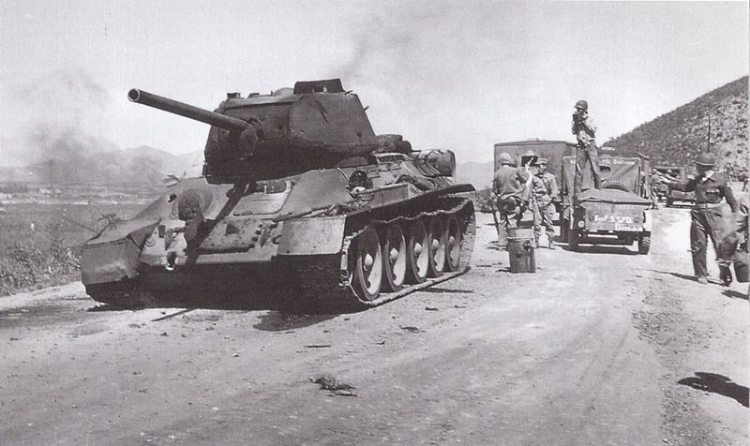
T-34 TANK WHICH HAD BEEN DISABLED
A PORTION OF ARMY MAP SERVICE SERIES L751, #6625 IV, DATED 1950
As you can see from the topographical map above, Task Force Smith's infantry occupied the highest ground anywhere between Suwon and Osan. The Command Post (CP) was located on the 113 meter (about 340 feet) hill which is shown just below (south) of the name "PANWOL-BONG". The next highest hill, just east of the CP is 92 meters (about 280 feet) high. The only hill in the area which is higher was one about 1,700 yards (just under a mile) to the southwest, located just before the "SAN" in "YOGYE-SAN". It is161 meters (about 500 feet) high but is not near any road or trail which would make it easily accessible.
A squad from the 2d platoon of B Company, reinforced by a light machine gun was on a hill just to the west of the road and just a little southwest of the hill where the CP was located. It is just above the letters "MY" of SONGHO-MYON". Their position was about 1,600 yards northeast of that 161 meter hill and well beyond the effective range (about 1,000 yards) of any machine gun.
The hill in the foreground is the one where the reinforced squad from "B" Company's 2d platoon was located. The 345 foot high hill where the rest of B Company was located is just behind it and overlooks it. The 285 foot high hill is behind the 345 foot high hill and cannot be seen.
VIEW ABOVE IS FROM THE 340 FOOT HIGH HILL JUST TO THE EAST (RIGHT) OF THE ROAD ON WHICH THE NORTH KOREAN T-34'S ADVANCED.
This is a recent picture of the ridge line where Task Force Smith's infantry dug in. In 1950 the road at the left was a two lane dirt road, loosely graded. The elevation to the left according to the 1950 topographical map of the area was about 345 feet high and the elevation to the right was about 285 feet high. In this view it is difficult to tell, but in 1950, there were two side by side railroad tracks which left Suwon south to Osan. They split just north of the elevation seen through the trees to the right, one line went to the right (east) of that elevation and the other line went to its west and went through an approximately 300 yard long tunnel between the 285 foot elevation and the 270 foot high elevation to its right. (east) According to the topographical map, the elevation farthest to the right was not as high as the elevation shown in the near right of this picture. According to that same map, the elevation seen to the left on the far side of the road was significantly lower than the elevation on this side of the road, possibly by as much as 23 meters (about 74 feet).
THE MAP ABOVE SHOWS THE TOWN OF OSAN-NI. THE MAIN ARTILLERY BATTERY WAS PLACED NEAR THE VILLAGE OF KWOL-LI ABOUT 100 YARDS WEST OF THE ROAD AND RAIL LINES. THIS IS PART OF THE AMS TOPOGRAPICAL MAP, WHICH SHOWS A MUCH LARGER AREA.
The 21st Infantry Regiment's War Diary states that 8 tanks were sighted at 7:00 AM as they were approaching the road and railroad crossing about three and a half miles north of Osan. Colonel Smith was notified and he ordered the artillery to open fire on coordinates 1004-1599. Of interest here is that the 52d FA Battalion War Diary puts the initial sighting at 7:45 AM and a report from Brigadier General Barth, who was the Acting Commander of the 24th Infantry Division Artillery stated that he was at the main artillery position when the first tanks were sighted. His report indicates that the first round fired was at about 8:18 AM. The coordinates listed above were about 4,800 yards north of the main artillery position and about 2400 yards north of the infantry positions. At the location where the infantry positions were located, there were two sets of railroad tracks separated by about 350 yards with the westernmost tracks passing through a tunnel for about 300 yards. The tunnel was located between two peaks with a hill about 285 feet high hill to the west and a lower hill (about 275 feet high) to its east, which was just west of the other rail line. The 75mm RR with "C" Company were located west of both sets of railroad tracks, which would probably place them on the 283 foot high hill. The War Diaries only mention that the 4.2 inch mortars were placed about 400 yards behind the infantry front, but, based on the topography, they were probably placed on the reverse slope of the 285 foot hill and in a line south along a low ridge line for about 500 yards almost due south. Logically, that would be the most likely as a cart track leaves the east side of the road almost opposite of where the one direct fire 105mm howitzer was located. The track curves around the east side of an approximately 125 foot high hill and runs north. Immediately north of that hill, the cart track splits in two and both go along a low ridge which is about 90 feet high for about 500 yards to the base of the 92 meter hill. They then merge and continue on to a group of buildings which begin on the western slope of the 285 foot hill and extends north for several hundred yards. Jeeps towing trailers containing the mortars would be able to easily travel either of those tracks as there are no steep inclines at any part of the cart track.
General Barth's report also mentions that the lead group of tanks had broken thru. Apparently immediately after the breakthrough by the tanks, he drove south, taking a side road to the east as the tanks had taken the main road through Osan. He drove to Ansong, probably on the same roads which Colonels Smith and Perry took separately later that same afternoon. The 21st Infantry War Diary states specifically that there were 31 tanks, five of which were destroyed. the 52d FA Battalion War Dairy states that there were between 30 and 40 tanks, 8 of which were destroyed. The Infantry War Diary is probably more accurate as they were located at a much higher elevation and the only elements of the infantry who were actually involved in a battle at that time were the 75mm recoilless rifles and the bazooka teams. The artillery were firing at tanks which at times were less that 200 yards away, with the direct fire 105mm howitzer firing at a range of about 140-150 yards. 1st Lt. Dwain L. Scott, Commander of A Battery states that the direct fire howitzer was where it was because there was not enough room to place it in the same area as the rest of the howitzers. Since it was forward of the main battery, it was decided to use it in a direct fire capacity and all 13 of the High Explosive Anti-Tank (HEAT) rounds were issued to that weapon. According to Corporal Critchfield, the fourth round loaded on that howitzer was defective and jammed into the breech and could not be quickly removed. At that point he states that two of the lead tanks had been knocked out. The crew returned to the main battery position. Neither Lt. Colonel Perry nor Lt. Scott mention any destroyed or damaged howitzers, other sources say that in the process, the direct fire 105 was destroyed and one of the other 105's was damaged. Based on the narrative by Herman Critchfield, if the direct howitzer was destroyed, it was after it had been abandoned. Communication between the artillery battery and the forward observers and the infantry Command Post was lost when the first tanks drove over the phone lines, which of necessity had to cross the road as all of the artillery was west of the road and the bulk of the infantry, the forward observers and the infantry command post were located east of the road.
The 52d FA Battalion War Diary states that only Colonel Perry and two enlisted men were wounded in the initial fighting. It also states that 5 officers and 20 enlisted men were missing. Two of the enlisted men returned to American lines on July 10 and two more the next day. Final results show that 2 officers, 2d Lt. James L. Thompson and 1st Lt. John G. White were killed in action (KIA). Three others were captured, Captain Ambrose H. Nugent, who was released September 1, 1953, 1st Lt. Roger W. Hartman, whose date of death in captivity is listed as February 28, 1951 and 2d Lt. Isadore Peppe who was released on August 30, 1953. Lt. Peppe had volunteered to lead the one bazooka and two .50 caliber machine gun crews lent by Lt. Colonel Perry to the Infantry contingent of Task Force Smith. Lt. Colonel Perry was wounded and remained on duty. Of the enlisted men, 5 were KIA and ten were captured. Five of the ten died in captivity and the other five were not released until the prisoner exchanges of late August 1953. Four enlisted men were missing, 3 of them wounded, but they returned to American lines (that would be the 2 each who returned on July 10 and 11). This data was obtained by using the the 52d FA Bn War Diary and the official Korean War Casualty Data File, available on line and also on file at National Archives II located in College Park, Maryland.
The 21st Infantry War Diary states that as the tank/artillery battle began, Colonel Smith consolidated all of his forces on the highest ground in the area, which would have been a 345 foot high hill immediately east of the road. The commander of the 2d Platoon of "B" Company, Lt. Alan Macaulay stated that only the 4th squad of the 2d platoon, reinforced by a machine gun occupied that hill and that when the order to withdraw from that hill, the machine gunner, PFC Florentine Gonsalez and his assisant gunner remained at their posts, covering the withdrawal. His assistant was killed and Gonsalez was captured and spent over 3 years as a POW. He was awarded the Distinguished Service Cross for his actions at Osan. PFC Gonsalez was so traumatized by this event that he refuses to talk about it. Another Platoon Leader, 1st Lt. William E. Wyrick, Commander of a platoon of C Company states that the only order he received was the one to prepare to cover the retreat of B Company. The Diary also says that after the tanks had all passed, the Task Force was subjected to artillery fire of apparently large caliber, and shortly afterwards an estimated regiment of North Korean infantry attacked. The War Diary also states that they received an order to prepare to withdraw at about 1:00 PM and that the order to withdraw came a half hour later at 1:30 PM. According to the War Diary, Lt. Thomas and "B" Company covered the withdrawal of "C" Company and then Captain Dashner and "C" Company leapfrogged past "B" Company and covered the withdrawal of "C" Company. A narrative of the action by retired Colonel William E. Wyrick, who was a 1st Lieutenant Platoon Commander in Company C, states that two platoons of Company C were supposed to cover the retreat of Company B and the balance of Company C. His platoon consisted of a total of 20 men at the beginning of the battle, but none of the men in his platoon made it to the designated point where they were to cover the retreat of the men of Company B. The diary states that Lt. Colonel Smith then took all available men south to Osan where they found most of the artillery vehicles intact. A narrative by the commander of Battery "A" explains why the tanks did not see the artillery trucks as he stated that after the trucks had been unloaded, they were taken to the northern outskirts of Osan, where walls of huts were removed, trucks driven inside and then walls were replaced. Everyone loaded onto the trucks and they apparently took the same side roads that General Barth had taken earlier and they arrived in Ansong at about 5:30 PM, where they remained overnight. Scott writes that the artillerymen took a jeep and 2 or three two and a half ton trucks (Corporal Critchfield's narrative confirms this except that Critchfield mentions taking a 3/4 ton vehicle in addition to the 6X6 trucks and the 1/4 ton jeep) and started driving west toward the ocean, but were blocked by a burning vehicle in the road, so they turned to go south thru Osan when they saw a T-34 tank in the road whose crew was all out of the tank, so they quickly turned around and went east and south to Ansong. He writes that Lt. Colonel Perry, Captain Simpson and he and the breech blocks were in the jeep with the balance of the artillerymen in the trucks. He makes no mention of Colonel Smith being with them. Lt Scott also states that they were carrying the howitzer breech blocks, which had been removed so the howitzers could not be used. On the way south they dumped those breech blocks into a rice paddy. For some reason, many of the retreating men attempted to head west toward the ocean and such was the case with Lt. Scott and several other men who furnished personal narratives. The only person who noted that he deliberately headed south and east was Lt. Wyrick because he reasoned that the North Koreans would make their fastest advance along the main road and rail route and their advance would be slower to the east where the terrain was more mountainous and the roads were less direct.
None of the War Diaries specifically mentions actions by recoilless rifles or bazooka teams. Picture of a bazooka appears below the map of the Osan area. Table of Organization and Equipment 7-17N dated March 1948, which was the document in effect until November 1950, states that the standard number of rocket rounds for an infantry platoon was only 7 rounds, with a total of 21 rounds for the entire company, so it is highly unlikely that one team would have as many as 22 rounds. Of interest here is the fact that the TO&E mentioned above lists the 3.5 inch bazooka as the authorized weapon and not the 2.36 inch which was actually in use in the Far East Command when the Korean War began.
GENERAL OVERVIEW OF BATTLE AT OSAN. RETREAT WAS NOT PLANNED, BUT WAS A ROUTE. BECAUSE THEY HAD EXPENDED ALL OF THE AMMUNITION AT THE MAIN POSITION AND THE TANKS PASSING THROUGH HAD HIT THE RESERVE STORAGE AREA AND DESTROYED ALL OF THE ARTILLERY AMMUNITION THERE, THE ARTILLERY BEGAN WITHDRAWING AT LEAST 15 MINUTES PRIOR TO THE INFANTRY BEGINNING THEIR WITHDRAWAL. THAT TIME ESTIMATE IS BASED ON THE NARRATIVE OF LT. DWAIN SCOTT, THE BATTERY COMMANDER, WHO STATED THAT JUST AS THE LAST ARTILLERY VEHICLE WAS LEAVING, INFANTRYMEN WERE BEGINNING TO STRAGGLE OVER THE HILL TO THEIR NORTH.
PHOTO OF SOLDIER WITH A 2.36 INCH BAZOOKA
ABBREVIATIONS USED IN CASUALTY REPORTING ARE: KIA = Killed in Action. MIA-RMC = Missing in Action, later Returned to Military Control. DIE = Died in Enemy Hands. WIA-RTD = Wounded in Action, Returned to Duty. MIA-Dead = Missing in Action, presumed Dead. EVAC = Wounded and Evacuated.
Total casualties among the infantry, again based on the official Korean War Casualty List, follows:
KIA - 41 non-medical personnel, 1 medic and 5 heavy weapons personnel. MIA-RMC - 1 Officer, 31 non-medical personnel, 10 medics and 5 heavy weapons personnel. DIE - 2 Officers, 21 non-medics, 1 medic and 3 heavy weapons personnel. WIA-RTD - 10 non-medics, 2 medics, and 2 heavy weapons personnel. MIA-Dead - 7 non medics. EVAC - 5 non-medics.
The Regimental War Diary states that the remnants of Task Force Smith were trucked to the airstrip at Taejon for reinforcements and replacement of lost equipment.
Total casualties among the artillery were as follows:
KIA - 5 EM and 2 officers//POW/DIED- 5 EM and 1 officer//POW/RMC-5 EM and 2 officers//WIA-3 em and 1 officer//MIA/RMC-3 EM.
Total number of officers in the artillery contingent was 11 American and 1 Korean artillery Captain/Interpreter. Total enlisted men was 170. The War Diary for the 52d Field Artillery Battalion only states that their lost equipment was replaced.
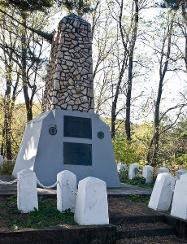
The monument shown above was the original monument erected to the men of Task Force Smith. The monument below is the latest one. It was erected by the 24th Infantry Division. The monument below was erected by the South Korean Government.
Finally, it is my belief that if General Dean had arrived in Taejon earlier, Task Force Smith and its supporting artillery would have been immediately sent to the Osan area, or if General Church had immediately sent Task Force Smith to the Osan area instead of splitting it between Pyongtaek and Ansong, thereby losing almost a full day, the communication lines could have been laid during daylight hours instead of during the night, thus raising the possibility that they could have been laid so that they would have been protected from being cut by tank treads, and making it possible for the four remaining operable 105mm howitzers to fire on the infantry when it arrived within range and before they even contacted the Task Force's infantry and also making it possible for more accurate mortar fire as the enemy came within range.
